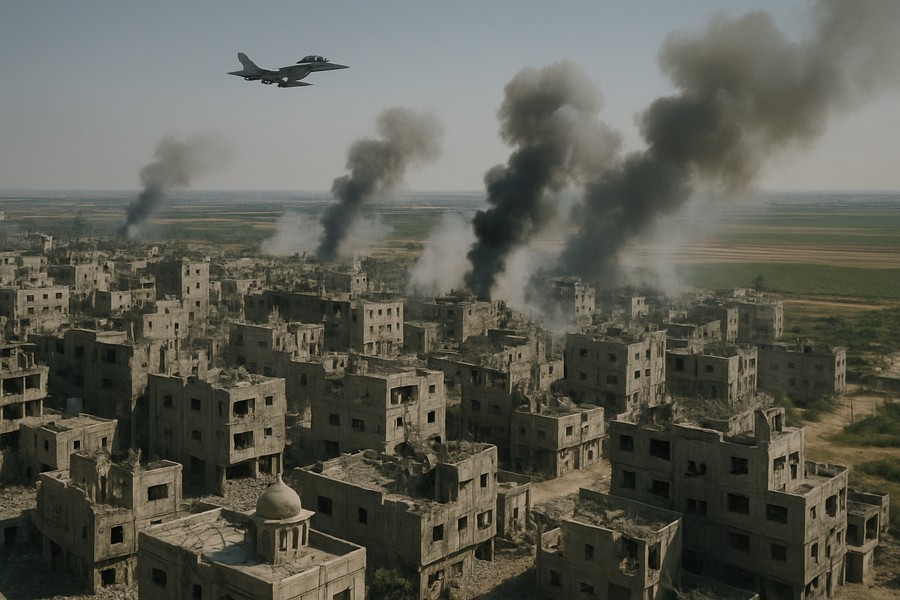
Airstrikes in Gaza: Israel's Response to Alleged Ceasefire Breaches
In recent developments in the Middle East, Israel has retaliated with airstrikes in southern Gaza. This move comes as a response to what Israel described as an audacious disregard for the ceasefire by Hamas, the Palestinian organization.
According to a military spokesperson, multiple infractions against Israeli forces were committed by Hamas, which Israel views as a serious breach of the recently instituted ceasefire. The breaches allegedly occurred beyond the previously agreed-upon demarcation, referred to as the "yellow line".
However, in a twist to the narrative, Hamas maintains its commitment to the ceasefire agreement and accuses Israel of multiple transgressions.
The Ceasefire Plan
The ceasefire agreement, which was implemented in mid-October, is part of an ambitious plan to terminate the long-standing conflict in Gaza. The initial phase of the agreement has led to the liberation of all living hostages and the return of 12 of 28 deceased ones to Israel.
In return, Israel has released 250 Palestinian prisoners along with 1,718 detainees from Gaza. Additionally, for every Israeli hostage's remains, Israel has returned 15 bodies of Palestinians.
The Triggering Event
The turn of events was ignited by a massive attack in southern Israel, which took place in early October. This assault, led by Hamas gunmen, resulted in approximately 1,200 deaths and 251 hostages. In response to this gruesome attack, Israel initiated a military campaign in Gaza. Since then, the death toll in Gaza due to the Israeli attacks has reportedly reached around 68,000.
Although the Israel Defense Forces (IDF) has not officially commented on the recent escalation, it was disclosed that the attacks by Hamas included an RPG (Rocket-Propelled Grenade) and sniper fire targeted at a military force. Notably, these incidents occurred in an Israeli-controlled area, to the east of the "yellow line".
The Current Scenario
Presently, IDF continues to hold the reins over just above half of the Gaza Strip, as per the ceasefire agreement. Meanwhile, Hamas, which has been in power in the territory for 18 years, faces opposition from armed groups such as the Popular Forces led by Abu Shabab. These groups, according to Hamas, are supplied with weapons and support by Israel.
In an attempt to regain control over Gaza, Hamas has reportedly called back approximately 7,000 of its security force members. The ceasefire agreement stipulates that Hamas should surrender its weapons to eliminate any threats to Israel.
Hamas, on the other hand, accuses Israel of empowering criminal gangs through funding and arming, leading to the looting of aid trucks and causing disorder in the region.
The Need for International Intervention
Without the presence of a robust international force in Gaza, the risk of intensifying conflict among Palestinian factions remains high. The ceasefire agreement also asserts that regional partners should ensure that Hamas and other factions in Gaza adhere to their obligations and do not pose a threat to the region or its people.
Any evidence of armed action by Hamas or other factions in Gaza would thus be viewed as a violation of the ceasefire agreement. The U.S. has already informed other guarantors of the Gaza peace agreement which include Egypt, Qatar, and Turkey, and demanded that Hamas uphold its end of the ceasefire terms.
The U.S. has issued a statement warning that if Hamas proceeds with its planned attack, measures will be taken to protect the people of Gaza and to preserve the integrity of the ceasefire agreement.
The Concern
The recent attacks have surfaced just hours after the U.S. claimed to have credible information about an imminent attack on civilians in Gaza by Hamas. Such an attack would be a blatant violation of the ceasefire agreement and would undermine significant progress achieved through mediation efforts.
Last week, graphic videos authenticated showed a public execution carried out by Hamas gunmen in Gaza. This, along with violent confrontations involving Hamas security forces and armed family members in Gaza City, resulted in 27 deaths, marking one of the most violent internal confrontations since the end of major Israeli operations in the region.
